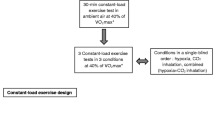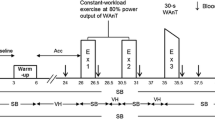Abstract
Baseline external respiration and gas exchange values, as well as ventilatory thresholds and sensitivity to the O2 and CO2 stimuli in hypoxic and hypercapnic tests, were measured 1 h before and after a session of intermittent normobaric hypoxia (INH) (six repetitions with a 5-min inhalation of a gas mixture (10% O2) alternating with a 3-min inhalation of atmospheric air). After an INH session, the background CO2 level in the lungs increased by 10%. In the hypercapnic test, the actuation threshold of the ventilatory response did not change, whereas ventilatory sensitivity increased. The maximal pulmonary ventilation and the corresponding critical CO2 level in the lungs also increased at the end of the test. In the hypoxic test, the ventilatory response occurred at a decreased level of blood oxygenation after an INH session, the pulmonary ventilation level being decreased and the CO2 content in the lungs being increased at the end of the test. The data obtained evidence the maintenance of changed gas homeostasis for 1 h after an INH session. In this process, control of respiration was effected, with the hypoxic drive being weakened and the peripheral chemoreceptor sensitivity being decreased. The hypercapnic drive also increased, which may be determined by readjustment in the central mechanisms of respiratory regulation.
Similar content being viewed by others

REFERENCES
Breslav, I.S. and Pyatin, V.F., Regulation of Respiration, in Fiziologiya dykhaniya (Physiology of Respiration), St. Petersburg: Nauka, 1994, p. 416.
Nattii, E.E., CO2, Brainstem Chemoreceptors, and Breathing, Prog. Neurobiol., 1999, vol. 59, no. 4, p. 299.
Fitzgerald, R.C., O2 and Carotid Body Chemotransduction: Holinergetical Concept-Short History and New Estimation, Resp. Physiol., 2000, vol. 120, p. 89.
Read, D.J., A Clinical Method for Assessing the Ventilatory Response to Carbon Dioxide, Aust. Ann. Med., 1967, vol. 16, p. 20.
Weil, J.V., Burne-Wuinn, E., Sodal, I.D., et al., Hypoxic Ventilatory Drive in Normal Man, J. Clin. Invest., 1970, vol. 49, p. 1061.
Duffin, J.Mc. and Avoy, G.V., The Peripheral Chemoreceptor Threshold to Carbon Dioxide in Man, J. Physiol., 1998, vol. 406, p. 15.
Akhmedov, K.Yu., Dykhanie cheloveka pri vysokogornoi gipoksii (Human Breathing under Mountainous Hypoxia Conditions), Dushanbe: Donish, 1971.
Fatemian, M. and Robinse, P.A., Selected Contribution: Chemoreflex Responses to CO2 before and after Exposure to Hypoxia in Humans, J. Appl. Physiol., 2001, vol. 90, no. 4, p. 165.
Krivoshchekov, S.G., Roifman, M.D., Divert, G.M., et al., Systemic Reactions and Central Mechanisms of Regulation in Adaptation to Cold and Hypoxia, Vestn. Akad. Med. Nauk, 1998, no. 9, p. 48.
Davidson, A.C. and Cameron, T.D., Ventolatory Control in Normal Man Following Five Minutes' Exposure to Hypoxia, Respir. Physiol., 1985, vol. 60, no. 2, p. 227.
Serebrovskaya, T.V., Svanson, R.D., Karaban, I.N., et al., Intermittent Hypoxia Changes Hypoxic Ventilatory Response, Fiziol. Zh., 1999, vol. 45, no. 5, p. 9.
Kolchinskaya, A.Z., Hypoxic Hypoxia, Exercise-Induced Hypoxia: Damaging and Constructive Effects, Hypoxia Medical J., 1993, no. 3, p. 8.
Luk'yanova, L.D., Modern Problems of Experimental and Clinical Hypoxia, Mater. II Vseross. konf. “Gipoksiya: mekhanizmy, adaptatsiya, korrektsiya” (Proc. II All-Russian Conf. “Hypoxia: Mechanisms, Adaptation, and Correction”), Moscow: BEBiM, 1999, p. 41.
Grippi, M.A., Patofiziologiya legkikh (Pathophysiology of the Lungs), Moscow: Binom, 1997 (Russian translation).
Fidone, S.J. and Gonzalez, C., Initiation and Control of Chemoreceptor Activity in the Carotid Body, in Handbook of Physiology, Sect. 3: Respiratory Physiology, Behtesda, 1986, vol. 2, p. 247.
Fitzgerald, R.S., Zaitchuk, J.F., Penman, R.W., et al., Am. J. Physiol., 1964, vol. 207, p. 1305. (Breslav, I.S., Respiratory Reflexes from Chemoreceptors, in Fiziologiya dykhaniya (Physiology of Respiration), Leningrad: Nauka, 1973, p. 165).
Konza, E.A., Involvement of Arterial Chemoreceptors in the Regulation of Rat Breathing in Hypoxia, Abstract of Cand. Sci. (Biol.) Dissertation, Leningrad: 1972.
Breslav, I.S. and Glebovskii, V.D., Regulyatsiya dykhaniya (Regulation of Respiration), Leningrad, 1981.
Vizek, M., Pickelt, C.K., and Weil, J.V., Biphasic Ventilatory Response of Adult Cats to Sustained Hypoxia Has Central Origin, J. Appl. Physiol., 1987, vol. 63, p. 1658.
Marshak, M.E., Regulation of Respiration, in Fiziologiya dykhaniya (Physiology of Respiration), Leningrad: Nauka, 1973, p. 256.
Fitzgerald, R.S., Shirahata, M., and Yaz, T., Further Holinergetical Aspects of Carotid Body Chemotransduction Hypoxia in Cats, J. Appl. Physiol., 1997, vol. 82, p. 819.
Agajanyan, N.A., Ecological Physiology: The Problem of Adaptation and the Strategy of Survival, Mater. X mezhdunar. simp. “Ekologicheskie problemy adaptatsii” (Proc. X Int. Symp. “Ecological Problems of Adaptation”), Moscow: Ross. Univ. Druzhby Narodov, 2001, p. 5.
Gusev, E.I. and Kazantseva, N.V., Baroterapiya v kompleksnom lechenii ishemii i gipoksii mozga. Posobie dlya vrachei (Barotherapy in the Complex Treatment of Cerebral Ischemia and Hypoxia. Handbook for Doctors), Moscow: NTs SSKh im. A.N. Bakuleva Ross. Akad. Med. Nauk, 2001.
Leutin, V.P., Platonov, Ya.G., Divert, G.M., et al., Inversion of Hemispherical Dominance as a Psychophysiological Mechanism of Interval Hypoxic Training, Fiziol. Chel., 1999, vol. 25, no. 3, p. 65.
Aleksandrov, M.V., Ivanov, A.O., Kosenkov, N.I., et al., The Influence of Hypoxic Hypoxia on the Spontaneous Activity of the Human Brain, Fiziol. Chel., 2001, vol. 27, no. 6, p. 58.
Serebrovskaya, T.V., Sensitivity to Hypercapnic and Hypoxic Stimuli as a Reflection of Individual Resistance of the Human Body, Patol. Fiziol. Eksp. Ter., 1985, no. 5, p. 65.
Medvedev, V.I. and Mirolyubov, A.V., The Problem of Control of the Functional State of Humans, Fiziol. Chel., 1984, vol. 10, no. 5, p. 761.
Medvedev, V.I., On the Problem of Adaptation, in Komponenty adaptatsionnogo protsessa (Components of the Adaptation Process), Leningrad, 1984, p. 3.
Volozhin, A.I. and Subbotin, Yu.K., Adaptatsiya i kompensatsiya-universal'nyi biologicheskii mekhanizm prisposobleniya (Adaptation and Compensation Are a Universal Biological Mechanism of Adjustment), Moscow: Meditsina, 1987.
Krivoshchekov, S.G. and Divert, G.M., The Principles of Physiological Regulation of Bodily Functions in Incomplete Adaptation, Fiziol. Chel., 2001, vol. 27, no. 1, p. 127.
Author information
Authors and Affiliations
Rights and permissions
About this article
Cite this article
Krivoshchekov, S.G., Divert, G.M. & Divert, V.E. Effect of Short-Term Intermittent Normobaric Hypoxia on the Regulation of External Respiration in Humans. Human Physiology 28, 676–681 (2002). https://doi.org/10.1023/A:1021196105213
Issue Date:
DOI: https://doi.org/10.1023/A:1021196105213



